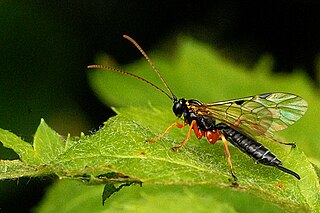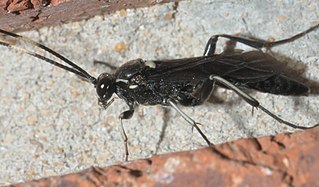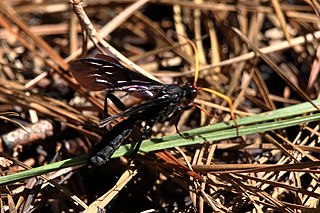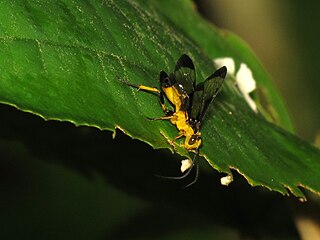
The superfamily Ichneumonoidea contains one extinct and three extant families, including the two largest families within Hymenoptera: Ichneumonidae and Braconidae. The group is thought to contain as many as 100,000 species, many of which have not yet been described. Like other parasitoid wasps, they were long placed in the "Parasitica", variously considered as an infraorder or an unranked clade, now known to be paraphyletic.

The Ichneumonidae, also known as ichneumon wasps, ichneumonid wasps, ichneumonids, or Darwin wasps, are a family of parasitoid wasps of the insect order Hymenoptera. They are one of the most diverse groups within the Hymenoptera with roughly 25,000 species described as of 2016. However, this likely represents less than a quarter of their true richness as reliable estimates are lacking, along with much of the most basic knowledge about their ecology, distribution, and evolution. It is estimated that there are more species in this family than there are species of birds and mammals combined. Ichneumonid wasps, with very few exceptions, attack the immature stages of holometabolous insects and spiders, eventually killing their hosts. They thus fulfill an important role as regulators of insect populations, both in natural and semi-natural systems, making them promising agents for biological control.

Cryptinae is a subfamily of wasps in the family Ichneumonidae. The family has also been called Gelinae, Hemitelinae, and Phygadeuontinae by various authorities, though the Phygadeuontinae have since been elevated to a separate subfamily.

Banchinae is a subfamily of ichneumonid parasitoid wasps containing about 1,500 species; the genera Glypta and Lissonota are very large. The three tribes are all distributed worldwide.

Pimplinae are a worldwide subfamily of the parasitic wasp family Ichneumonidae.

Ichneumoninae is a worldwide subfamily of the parasitic wasp family Ichneumonidae.
In this checklist are presented all wasp species of family Ichneumonidae.
Gerd Hermann Heinrich was a German entomologist and ornithologist known for his studies of parasitic Hymenoptera of the Ichneumonidae family and for the description of several bird species in Celebes, Dutch East Indies.

Ichneumonini is a tribe of ichneumon wasps in the family Ichneumonidae. There are more than 350 genera and thousands of described species in Ichneumonini.

Dusona is a genus of parasitoid wasps belonging to the family Ichneumonidae. It is the most species rich genus of the subfamily Campopleginae with 442 known species.

Gnamptopelta obsidianator is a species of wasp in the family Ichneumonidae and the only species in the monotypic genus Gnamptopelta.

Macrojoppa is a genus of Ichneumonidae wasp.
Abzaria is a genus of ichneumon wasps in the family Ichneumonidae. There are at least two described species in Abzaria.
Eurylabus is a genus of ichneumon wasps in the family Ichneumonidae. There are about 11 described species in Eurylabus.
Alomyini is a tribe of ichneumon wasps in the family Ichneumonidae. There are two genera in Alomyini.

Joppa is a genus of Neotropical parasitoid wasps in the family Ichneumonidae.

Listrodromus nycthemerus, the holly blue Darwin wasp, is a species of ichneumon wasp belonging to the family Ichneumonidae. This species is a parasitoid, its sole host species being the holly blue butterfly.

Listrodromus is a genus of ichneumon wasps belonging to the family Ichneumonidae. These wasps are parasitoids of butterflies of the family Lycaenidae, laying eggs in the caterpillars.














